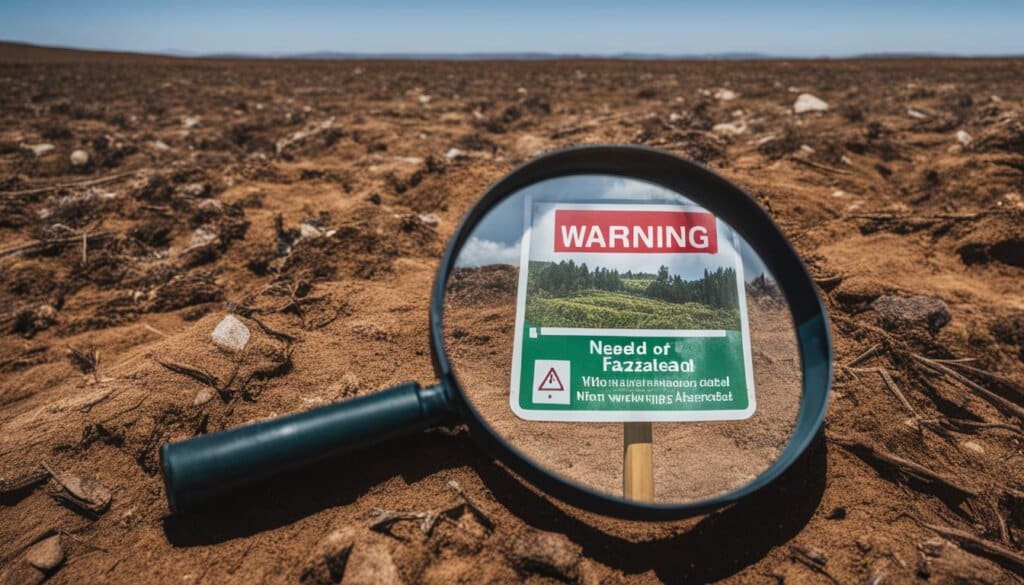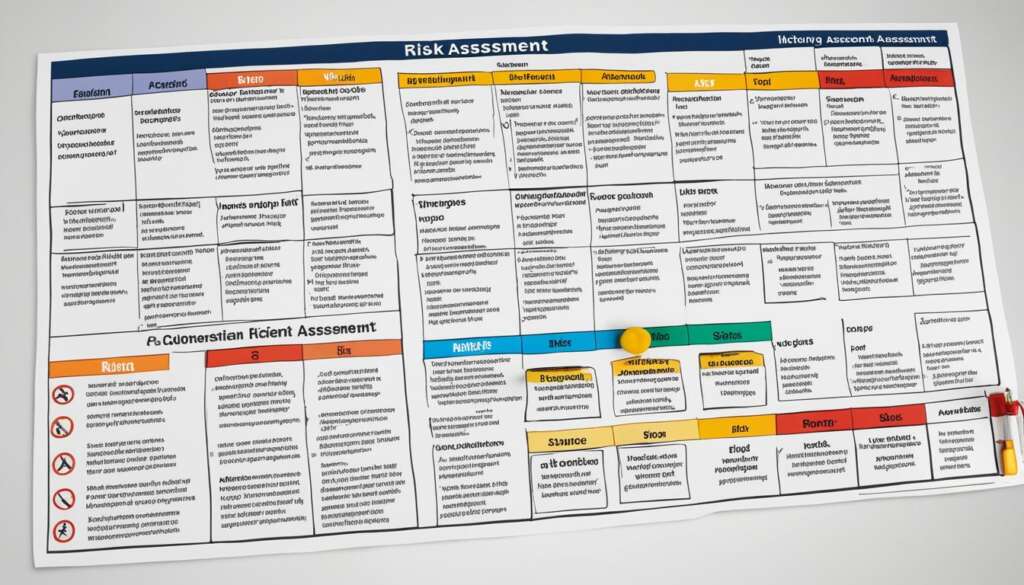Table of Contents
Risk assessment is a vital process for businesses to identify and evaluate potential hazards and business risks. It involves analyzing the potential threats that could impact a company’s operations, as well as the safety of its employees and customers. By understanding these hazards, organizations can implement effective risk control measures to mitigate the impact of such risks.
Different industries face different types of hazards, making risk assessments unique to each industry. The primary goal of risk assessment is to determine the necessary measures that should be implemented to minimize identified risks and ensure the health and safety of employees and customers.
During a risk assessment, vulnerabilities and weaknesses within a business are also analyzed. This includes factors such as construction deficiencies, security issues, and errors within process systems. By identifying and addressing these vulnerabilities, organizations can improve their overall safety and reduce the chances of potential hazards occurring.
Risk assessments are typically conducted by professionals such as chief risk officers or chief risk managers in large enterprises. They are an essential component of risk analysis, which aims to identify and analyze potential issues that could negatively affect key business initiatives or projects.
To learn more about the steps involved in risk assessments and how to effectively manage risks, continue reading.-
Risk Assessment Steps
In order to effectively manage and mitigate risks, organizations need to follow a systematic approach. The risk assessment process involves five key steps that can be applied across various industries to identify and evaluate risks. By following these steps, businesses can ensure the safety of their employees, protect their assets, and maintain operational continuity.
Step 1: Identify the Hazards
The first step in the risk assessment process is to identify potential hazards that could pose a threat to the organization. This includes considering various factors such as natural disasters, power failure, cyber attacks, and utility outages. By recognizing these hazards, businesses can better prepare for them and implement appropriate risk control measures.
Step 2: Discover what or whom could be harmed
Once the hazards are identified, the next step is to determine which aspects of the business could be negatively impacted by these risks. This includes critical infrastructure, IT systems, business operations, company reputation, and most importantly, employee safety. By understanding the potential harm, organizations can prioritize their risk mitigation efforts and allocate resources effectively.
Step 3: Evaluate the Level of Risk and Develop Control Measures
After identifying the hazards and potential harm, it is crucial to evaluate the level of risk associated with each identified hazard. This involves conducting a thorough risk analysis to determine the likelihood and potential consequences of the risks. Based on this analysis, organizations can then develop and implement appropriate risk control measures to minimize or eliminate the potential impact of these hazards.
Step 4: Record the Findings
Keeping a record of the risk assessment findings is an essential part of the process. It involves documenting the identified hazards, associated risks, and the control measures implemented to prevent or mitigate them. These records serve as official documents that can be referred to in the future and provide a reference point for regular reviews and updates.
Step 5: Regular Review and Update
Risk assessments should not be a one-time activity. It is important to regularly review and update the risk assessment as the business environment is constantly evolving.These reviews should be conducted periodically to adapt to changes in hazards, risks, and control measures. Regular reviews help ensure that the risk assessment remains relevant and effective in addressing the current and emerging risks that a business may face.
Please ensure all output is in British English.
How to Use a Risk Assessment Matrix
A risk assessment matrix is a valuable tool for evaluating and prioritizing risks based on their likelihood and impact. It allows organizations to determine the probability and potential consequences of events or hazards, enabling them to make informed decisions regarding risk management strategies. By using a risk assessment matrix, organizations can effectively allocate resources and develop targeted risk control measures.
The risk assessment matrix is typically presented as a chart, categorized by the level of likelihood and impact. It can be created in various formats, such as a 2×2, 3×3, 4×4, or 5×5 chart, depending on the level of detail required. The matrix is color-coded to represent different levels of risks, making it visually intuitive and easy to understand.
When assessing risks using the matrix, likelihood refers to the probability or chance that a given event or hazard will occur. Likelihood can be assessed using terms such as extremely likely, likely, unlikely, or highly unlikely. On the other hand, impact refers to the severity of the consequence or outcome if the risk were to materialize. Impact can be evaluated in terms of various levels of injury severity, such as fatal, major injury, minor injury, or negligible injuries.
Within the risk assessment matrix, the combination of the assigned likelihood and impact levels determines the risk score. The risk score indicates the overall level of risk associated with each identified hazard or event. Higher scores signify higher levels of risk and require more immediate attention and mitigation efforts.
Quantitative and Qualitative Risk Assessments
There are two primary approaches to conducting risk assessments: quantitative and qualitative. In quantitative risk assessments, numerical values are assigned to the likelihood and impact of risks. These values can then be used to calculate the risk factor, enabling organizations to prioritize risks based on their quantitative analysis. This approach is ideal when precise data is available and a more detailed understanding of risks is required.
Conversely, qualitative risk assessments do not involve specific numerical values. Instead, risks are ranked or categorized based on their level of danger or severity. This approach provides a more subjective analysis but can be useful when limited data is available or when the focus is on a broader overview of risks.
Both quantitative and qualitative risk assessments have their advantages and can be used depending on the organization’s needs and the availability of data. It’s important to choose the approach that best aligns with the objectives and resources of the organization.
Using a risk assessment matrix empowers organizations to prioritize risks effectively, allocate resources, and develop appropriate risk control measures. The visual representation of the matrix provides a clear overview of the likelihood and impact of identified risks, allowing for informed decision-making. Whether utilizing a quantitative or qualitative approach, the risk assessment matrix serves as a valuable tool in comprehensive risk management.
Quantitative vs. Qualitative Risk Assessments
Risk assessments can be categorized as either quantitative or qualitative. Each approach has its advantages and is used depending on the organization’s specific needs and available data.
Quantitative Risk Assessment
In a quantitative risk assessment, numerical values are assigned to the probability and impact of an event. These values allow for a more precise and data-driven analysis of risks. By assigning numerical values, organizations can calculate a risk factor that can be mapped to a dollar amount. This quantitative approach provides a detailed understanding of the potential financial impact of identified risks.
For example, in a quantitative risk assessment, a company might assign a numerical value of 0 to 10 to the probability of a particular risk occurring, as well as a numerical value of 0 to 10 to the potential impact if that risk were to materialize. These numerical values can then be multiplied together to obtain a risk factor, such as 6 out of 100, indicating a moderate level of risk.
Qualitative Risk Assessment
On the other hand, qualitative risk assessments do not involve assigning numerical probabilities or predictions of loss. Instead, risks are ranked based on their level of danger or impact. This allows for a simpler and more subjective analysis, especially when limited data is available or a general understanding of risks is sufficient.
An example of a qualitative risk assessment approach is to rank risks as high, medium, or low based on their perceived level of danger or impact. This ranking helps organizations prioritize risks and allocate resources accordingly.
Both quantitative and qualitative risk assessments serve important purposes in risk management. While quantitative assessments provide a more detailed analysis of risks and their potential financial impact, qualitative assessments offer simplicity and subjectivity that can be beneficial when dealing with limited data or in situations where a broad understanding of risks is sufficient.
Ultimately, the choice between quantitative and qualitative risk assessments depends on the organization’s specific needs, available data, and the desired level of analysis and understanding of risks.
The Goals of Risk Assessments
The specific goals of risk assessments may vary based on the industry, business type, and compliance rules. However, the general goal of risk assessments is to evaluate potential hazards and remove or mitigate them.
By identifying and analyzing risks, organizations can achieve several important objectives:
- Prepare for potential threats: Risk assessments help organizations anticipate and prepare for potential hazards and risks that could disrupt their operations.
- Prevent injuries or illnesses: By identifying and assessing workplace hazards, risk assessments enable organizations to implement preventative measures that safeguard the health and safety of employees and customers.
- Meet legal requirements: Risk assessments ensure that organizations comply with laws and regulations related to health and safety, environmental protection, and data security.
- Create awareness about hazards and risks: Risk assessments raise awareness among employees, management, and stakeholders about the potential hazards and risks they may encounter, promoting a culture of safety and risk consciousness.
- Develop accurate inventories of assets: Risk assessments help organizations identify and quantify their assets, including physical infrastructure, intellectual property, and sensitive data, which allows for better risk management and resource allocation.
- Justify the costs of managing risks: Risk assessments provide organizations with the data and insights needed to justify investments in risk mitigation measures and allocate resources effectively.
- Determine the budget for risk remediation: By evaluating the potential impacts and costs associated with identified risks, risk assessments help organizations determine the appropriate budget for risk remediation efforts.
- Understand the return on investment in risk mitigation: Risk assessments enable organizations to evaluate the effectiveness of risk mitigation measures and understand the return on investment in terms of reduced losses and improved business performance.

Examples of Risk Assessments by Field
Risk assessments play a critical role in various fields and industries, helping organizations identify potential hazards and develop appropriate control measures. Here are some examples of risk assessments conducted in different domains:
Cybersecurity Risk Assessments
Cybersecurity risk assessments focus on identifying and prioritizing risks associated with an organization’s systems and data. It involves evaluating vulnerabilities, potential cyber threats, and their potential impact. By understanding these risks, organizations can implement robust cybersecurity measures to protect their digital assets.
IT Risk Assessments
IT risk assessments evaluate and identify potential risks facing information systems, networks, and data. This assessment aims to identify vulnerabilities, such as software vulnerabilities, network vulnerabilities, or weak access controls, which could lead to data breaches, system downtime, or unauthorized access.
Health and Safety Risk Assessments
Health and safety risk assessments focus on identifying hazards related to biological, chemical, energy, and environmental risks within a workplace. Assessments are conducted to ensure a safe working environment, prevent accidents, and mitigate risks to employees’ health and well-being.
Workplace Risk Assessments
Workplace risk assessments aim to identify and address potential health and safety hazards within a workplace. These assessments cover various aspects, including physical hazards, ergonomics, fire safety, and emergency response planning, to ensure a safe working environment for all employees.
Project Management Risk Assessments
Project management risk assessments involve identifying potential risks, hazards, and impacts that a project may face. Assessments help project managers understand the risks associated with project timelines, budgets, resource allocation, and stakeholder expectations, enabling them to develop effective risk mitigation strategies.
Environmental Risk Assessments
Environmental risk assessments focus on assessing the potential human or ecological health risks associated with exposure to environmental contaminants. These assessments analyze the impact of pollutants, hazardous substances, and other environmental factors on ecosystems, ensuring appropriate measures are taken to protect the environment and human health.
Climate Risk Assessments
Climate risk assessments evaluate the potential risks and impacts of climate-related events and trends. These assessments analyze factors such as extreme weather events, shifting climate patterns, and long-term environmental changes to understand their potential consequences and develop strategies to minimize damage and loss.
These examples highlight the diverse range of risk assessments conducted across different industries. Each assessment aims to identify and mitigate specific risks, ensuring the safety, security, and resilience of organizations and their stakeholders.
The Core Elements of Risk Assessment
The risk assessment process consists of four core elements: risk identification, risk analysis, risk evaluation, and risk communication. Let’s delve into each element:
Risk Identification
Risk identification involves identifying potential hazards and their causes, consequences, and vulnerabilities. It aims to uncover any factors that have the potential to harm the organization’s operations, employees, or stakeholders.
Risk Analysis
Risk analysis is the process of assessing the likelihood and severity of risks identified during the risk identification phase. It includes evaluating existing controls and their effectiveness in managing the identified risks. This analysis helps organizations understand the magnitude of each risk and prioritize their mitigation efforts.
Risk Evaluation
Risk evaluation involves comparing the results of the risk analysis to established risk criteria. By doing so, organizations can determine the significance of each risk and decide whether additional controls are necessary. This step helps organizations balance the costs and benefits of implementing risk mitigation measures and make informed decisions.
Risk Communication
Risk communication is an essential element of the risk assessment process. It involves effectively conveying the identified risks, analysis, and evaluation to stakeholders. Clear and concise communication ensures that all parties involved have a comprehensive understanding of the risks and the necessary preventive or mitigative measures. Open and transparent communication also fosters trust and encourages active participation in risk management efforts.
By incorporating these core elements into their risk assessment process, organizations can gain a holistic understanding of their risks and develop effective strategies to manage and mitigate them.
The Importance of Risk Management and Assessment
Risk management and assessment are essential components in any organization’s efforts to reduce operational risks, improve safety performance, and achieve its objectives. By conducting thorough risk assessments, organizations can proactively identify and prepare for potential risks, safeguarding the health and safety of their personnel.
The risk assessment process involves several key steps, starting with the identification of hazards and the analysis of associated risks. By evaluating the levels of risk involved, organizations can determine appropriate measures to mitigate these risks. Effective communication of the assessment findings to all stakeholders is crucial to ensure a comprehensive understanding of the risks and the necessary preventive or mitigative actions.
By gaining a deeper understanding of the hazards and risks present within their facilities and processes, organizations can implement preventive measures to enhance workers’ health and safety. This proactive approach not only reduces operational risks but also aids in compliance with laws and regulations, creates awareness about potential hazards and risks, and facilitates the allocation of appropriate resources for risk mitigation. Ultimately, risk management and assessment contribute to a comprehensive health and safety management plan, enabling organizations to effectively handle any potential risk that may arise.
FAQ
What is risk assessment?
Risk assessment is the process of identifying and evaluating potential hazards that could negatively impact a business’s operations and the safety of its employees and customers. It helps identify inherent business risks and prompts the implementation of measures, processes, and controls to reduce the impact of these risks.
What are the steps in the risk assessment process?
The risk assessment process involves identifying hazards, evaluating the level of risk, developing control measures, recording the findings, and regularly reviewing and updating the assessment.
How do I use a risk assessment matrix?
A risk assessment matrix is a visual tool used to determine the likelihood and potential consequences of events or hazards. It helps organizations evaluate and prioritize risks based on their likelihood and impact.
What is the difference between quantitative and qualitative risk assessments?
In a quantitative risk assessment, numerical values are assigned to the probability and impact of an event. These values can be used to calculate a risk factor. On the other hand, qualitative risk assessments rank risks based on their level of danger without involving numerical probabilities or predictions of loss.
What are the goals of risk assessments?
The general goals of risk assessments are to evaluate potential hazards, remove or mitigate them, create awareness about hazards and risks, comply with laws and regulations, and determine the necessary budget and resources for risk remediation.
What are some examples of risk assessments by field?
Examples of risk assessments by field include cybersecurity risk assessments, IT risk assessments, health and safety risk assessments, workplace risk assessments, project management risk assessments, environmental risk assessments, and climate risk assessments.
What are the core elements of risk assessment?
The core elements of risk assessment are risk identification, risk analysis, risk evaluation, and risk communication.
Why is risk management and assessment important?
Risk management and assessment play a crucial role in reducing operational risks, improving safety performance, and achieving organizational objectives. They help identify potential risks, protect the health and safety of personnel, comply with laws and regulations, create awareness about hazards and risks, and determine the necessary budget and resources for risk remediation.













